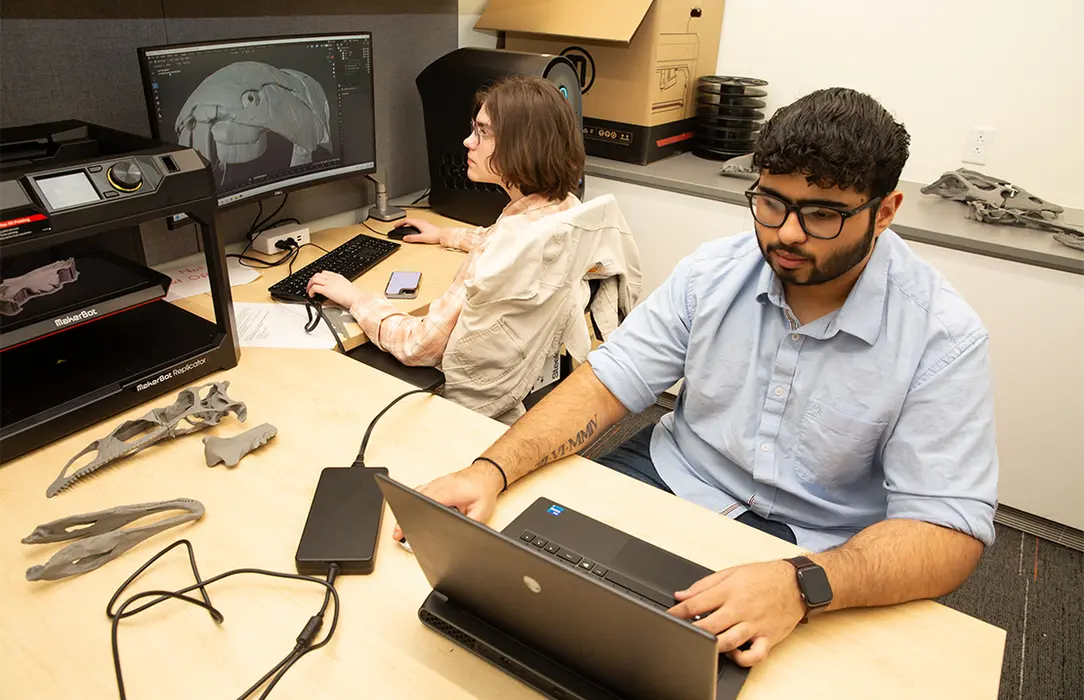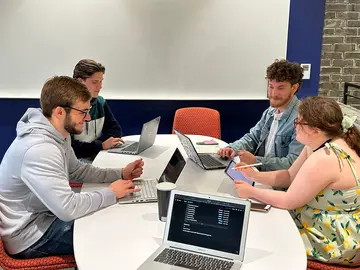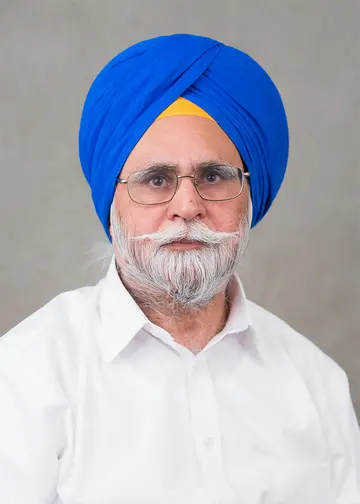Students create 3D skulls in project funded by Costello award connecting biology, computer science and art

At work on the 3D skull project in the Houghton Hall Room 233 are Fiona Rigney (center) and Ishaan Prathamesh Rangnekar.
Creating a 3D skull collection basically from scratch – made particularly unique because it’s a collaborative project engaging students enrolled in seemingly distant academic areas – is opening new educational opportunities at SUNY Fredonia.
“The Art of Natural History: 3D Printing a Skull Collection” explores the natural history of objects (biology/paleontology), the manipulation and preparation of digital models (computer science) and the fabrication of the printed pieces into final pieces (art). Students in three disciplines have integral roles in building the 3D printed skull collection.
“The goal of the project is to make a 3D printed skull collection that we use for teaching and for outreach,” explained Department of Geology and Environmental Sciences Associate Professor Thomas Hegna. Physical models are considered the most accurate way to display the anatomy, as well as one of the most impactful ways to facilitate learning, Dr. Hegna explained. Two dimensions are not always adequate for learning, hence the impetus to pursue creation of 3 D representations.
“What I notice is that students really enjoy working with these models that become a real touchstone, where they are able to make connections with the physical object,” Hegna remarked.
“From a replica, one can experience and interact with the object in 3D in a way that is not possible with drawings or computer animations,” he added. All student work in this project occurs outside of their regular courses.
3D printing technology makes it both possible and feasible to reproduce a wide variety of skulls that may not be available for a variety of reasons. Skulls of extinct animals, for example, may not be accessible or can be exorbitantly expensive to acquire or to buy real casts so new models can be created.
We’re actually taking models, sizing them, scaling and manipulating and cutting them so they can be pieced together; it’s like putting a model together. In the end we come up with something that is realistic and pretty much actually what the skeleton should look like.” - Derrik Decker
A Costello Interplay Award for Science and the Arts, supported by the Costello Interplay Fund through the Fredonia College Foundation, is underwriting the unique endeavor. The fund awards grants to faculty and students to pursue projects that explore the intersections between visual and performing arts and the natural and mathematical sciences. A nearly $5,500 grant is covering the cost of supplies and student stipends.
Hegna has assembled a wide-ranging collection of skulls over several years from a variety of sources that serve as the project’s starting point. Some are of living animals (gorillas), extinct animals (the dinosaur Stegosaurus), small animals (the platypus) and large animals (the almost 6-foot-long skull of Tylosaurus). They vary greatly in size, and very large ones create a unique reproduction challenge to be overcome.
Smaller models can be printed on an existing campus 3D printer, but larger models will need to be digitally cut into pieces, in order to fit the constraints or size limitations of the 3D printer.
Computer science students, led by Department of Computer and Information Sciences Adjunct Lecturer Derrik Decker, turn the models into printer-sized pieces. An original scan is made and then the best way to cut it into pieces, if necessary, has to be determined.
“We’re actually taking models, sizing them, scaling and manipulating and cutting them so they can be pieced together; it’s like putting a model together,” Mr. Decker explained. “In the end we come up with something that is realistic and pretty much actually what the skeleton should look like.”

Students in Decker’s CSIT 203: Introduction to Multimedia Systems who are familiar with Blender, a 3D model and animation software, were enlisted for the project. They use Alienware computers and MakerBot 3D printers in Houghton Hall to make the models.
After taking the original scan, students determine the best way to cut it into slices, so it can be handled – one section at a time – by a 3D printer. Printing is a very detailed process that can be an extremely lengthy, Decker adds, and in extreme cases can require as many as 20 hours to print one part or section. Some models have to be broken down into as many as eight pieces.
The primary job of Fiona Rigney, a junior from Buffalo, NY, is “cleaning up” the 3D models she’s placed in Blender, the computer program. She adjusts the size and scale of each model and fixes vertices that may have been in the wrong place. Since the models are from different scientists and other third-party sources, there are different ways that they are created, and thus different ways they need to be prepared for printing.
“My other job is to split up the models so that they can be printed. Some of these are (obviously) very big, and so I have to slice them into separate parts before they are sent off to the sculptor, who will then fit them together again,” explained Ms. Rigney, who joined the project last fall. “Skulls – and other fossil models – have a lot of variation, and it's important to make a decision on where to split the model so that there won't be any places where other pieces might get separated in the process. It's kind of like a jigsaw puzzle, but in reverse,” she added.
Some scans encompass both the skull and the jaw as one unit, but to print them, the jaw must be digitally separated from the model of the skull so that the two parts can freely move in the final model.
“Overall, I’m really overjoyed to be working on this project,” Rigney said. “As a really young kid, I was super into dinosaurs, so it's kind of nostalgic to apply the skills I've learned to something that means a lot to me,” Rigney explained. As a Computer Science major, Rigney said there are many different kinds of things she wants to do in a career, “so the idea of working with 3D models in this way has opened up yet another pathway for something I can do in the future.”
Primary duties of Ishaan Prathamesh Rangnekar, a sophomore Computer Science major from Mumbai, India, are to slice the 3D models in an STL file format in Meshmixer, or Blender, into smaller parts so they fit within the print. He also does troubleshooting with the printers, ensuring they are running correctly.
“The major takeaways I have had from this project are that I learned how to use my skills with Blender on 3D models that are very complicated (along with) time-management, work ethic, communication, and organization of my work,” Mr. Rangnekar said. Staying connected with team members through updated spreadsheets and email promotes efficient use of everybody’s time, he added.
“Both Ishaan and Fiona are just excited by the application (of this knowledge) in a new area,” Hegna noted. “They don’t get to work with fossils in the Computer Science department.”

Decker views the 3D printing and natural history project as “a great experience of applying what you learn at the classroom level to now it’s more like research – a terrific opportunity to take something from a classroom situation to where it’s real life, actually applying what you learn in the classroom.”
Students from Geology and Environmental Sciences, guided by Hegna, do the printing and troubleshooting.
Syd Lamberton, a senior Adolescence Education: Earth Science major from Pennsylvania, works with a 3D filament printer and a resin printer to create the models, since the printers vary in degrees of precision and detail. She also joined the project last fall, initially concentrating on troubleshooting and technical issues with the resin printer.
The process involving the filament printer (which uses a spool of plastic “thread”) consists of cleaning the build platform, loading the filament, and monitoring the progress of the print to look for errors. Most of the work is done with the resin printer using computer software to scale models, adding printing supports and managing the digital models that are used for printing.
The 3D resin printer allows for higher precision and detail. Once the models have been cured completely over a few days under observation, Ms. Lamberton sands off any remaining point contacts and identifies any flaws or repairs that need to be addressed.
“This project has been an incredible learning opportunity,” Lamberton remarked. “I did not previously have experience with 3D printing, but I have learned the ins and outs of the process quite quickly with Dr. Hegna. I have enjoyed learning the technical aspects of the printing process and about the organisms that we are modeling.”
Just how much Lamberton has learned in this project was apparent during a recent trip to the Smithsonian National Museum of Natural History with the department club. “I was able to identify and discuss with my peers the organisms that I have worked with. This was an unexpected opportunity to apply what I have learned to teach others.”
As a future teacher, Lamberton will be able to leverage her experience by incorporating 3D printing technology in her classrooms. These newly acquired skills will enable Lamberton to create interactive learning materials, leading to multimodal learning among students. They will be taught how to use the technology for their own growth in whatever field they choose, she said.
The finished printed piece or pieces are transferred to Department of Visual Arts and New Media Associate Professor Peter Tucker, who guides sculpture students in the fabrication phase that involves assembly, if needed, and finish work of the models.
Jasper Glow, a senior majoring Visual Arts and New Media: Sculpture from North Collins, NY, describes his assignment as post production. “I sand the pieces, assemble the skulls, apply a smoothing agent, and then paint them,” he explained.
“My biggest personal takeaway comes more in the form of the methods of attachment and smoothing I’ve learned through the process of working on this project. I would’ve never thought to use the materials recommended to me as a smoothing agent, but the water putty that I use actually works very well,” Mr. Glow explained.
Glow was regularly using store bought wood filler to smooth out 3D prints, but has found water putty to be more cost effective. He’s also currently using it on a personal project, a 3D printed mask modeled after the masks worn on stage by members of Ghost, a Swedish rock band that’s one of his favorites.
Using CT scans to produce 3D models of fossils is not a foreign experience for Hegna. While teaching at the Western Illinois University, he was awarded the WIU Provost’s Excellence Award for Teaching with Technology in 2016 for spearheading a similar 3D printing project that involved fossils and produced 3D printable models made from available CT-scan movies. He found post-processing of printed models through sanding, painting and other measures can make the models almost visually indistinguishable from real specimens.
“This one is much more ambitious and has a more interdisciplinary reach,” Hegna said, compared to his WIU project.
There are nearly 15 skulls in various stages of assembly, and some were exhibited by students at the recent Earth Science Student Forum at the Buffalo Museum of Science. A public art/science showing on campus may be held in the fall semester. Hegna will also utilize the models in earth history and paleontology courses he teaches, and models may ultimately be placed in the Stanley Museum in Houghton Hall.
As many as 20 skull reproductions may be completed by the end of the spring semester.
Hegna is looking forward to making a trilobite shell that will be placed on a remote-control car. “The model is an articulated model, so as it drives, there will be wiggle along the joints.”



